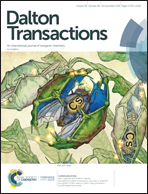Hysteretic thermal spin-crossover in heteroleptic Fe(ii) complexes using alkyl chain substituted 2,2′-dipyridylamine ligands†
Abstract
The alkyl chain carrying ligands N,N-di(pyridin-2-yl)butanamide (LC4) and N,N-di(pyridin-2-yl)decanamide (LC10) were combined with NCS− co-ligands to form the neutral heteroleptic Fe(II) complexes trans-[FeII(LC4)2(NCS)2] (1C4) and trans-[FeII(LC10)2(NCS)2] (1C10). Variable temperature crystallographic studies revealed that 1C4 is in the orthorhombic space group Pna21 between 85–200 K whereas 1C10 is in the monoclinic space group P21/c between 85–140 K. The average Fe–N bond lengths suggest that at 85 K 1C4 contains LS Fe(II) centres; however, the ca. 0.18 Å increase in the average Fe–N bond lengths between 85 and 120 K suggests a spin-transition to the HS state occurs within this temperature interval. 1C10 contains LS Fe(II) centres between 85 and 105 K. Upon warming from 105 to 140 K the average Fe–N bond lengths increase by ca. 0.19 Å, which suggests a spin-transition to the HS state. Solid-state magnetic susceptibility measurements showed that 1C4 undergoes semi-abrupt spin-crossover with T1/2 = 127.5 K and a thermal hysteresis of ca. 13 K whereas, 1C10 undergoes an abrupt spin-crossover with T1/2 = 119.0 K, and is also accompanied by thermal hysteresis of ca. 4 K. The crystallographic and magnetic data show that the length of the complex's alkyl chain substituents can have a large impact on the structure of the crystal lattice as well as a subtle effect on the T1/2 value for thermal spin-crossover.



 Please wait while we load your content...
Please wait while we load your content...